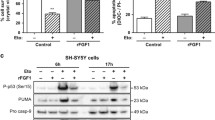Abstract
Astrocytomas are the most common primary tumor of the adult human central nervous system. Despite efforts to develop more effective clinical treatment strategies, median survival time for patients with the most severe form of astrocytoma, glioblastoma multiforme (GBM), remains about one year. Astrocytomas are resistant to cytotoxic therapy in general and radiation therapy in particular, greatly limiting treatment options. One reason for this seems to be defects in the pathways controlling apoptosis. We have characterized the role of the tyrosine phosphatase FAP-1 (FAS-associated phosphatase 1) in astrocytomas. Our studies demonstrate that FAP-1 is overexpressed in astrocytomas and this contributes to the resistance of the tumor cells to FAS-mediated apoptosis. We demonstrate that knockdown of FAP-1 by RNA interference leads to increased apoptosis and increased sensitivity of astrocytoma cells to FAS-induced cell death. FAP-1 binds to FAS in a ligand-dependent manner and forms a signaling complex that modulates the ability of astrocytoma cells to undergo FAS ligand (FASL)-mediated cell death. In astrocytoma cells, FASL treatment induces tyrosine phosphorylation of FAS. FAP-1 dephosphorylates phospho-tyrosine 275 in the carboxyl terminus of FAS. This is the first direct evidence that FAS activity can be regulated by reversible phosphorylation and suggests a mechanism for astrocytoma resistance to apoptosis.
Similar content being viewed by others
References
Kleihues P, Cavenee WK : Tumors of the Nervous System. World Health Organization Classification of Tumors. IARC Press, 2000
Berger SM, Wilson SB: The Gliomas. W.B. Saunders Company, 1999
M Weller U Malipiero A Rensing-Ehl PJ Barr (1995) ArticleTitleFAS/APO-1 gene transfer for human malignant glioma Cancer Res 55 2936–2944 Occurrence Handle7540953
GL Yount KS Levine H Kuriyama DA Haas-Kogan M Israel (1999) ArticleTitleFAS (APO-1/CD95) signaling pathway is intact in radio resistant human glioma cells Cancer Res 59 1362–1365 Occurrence Handle10096571
TC Maleniak JL Darling PR Lowenstein MG Castro (2001) ArticleTitleAdenovirus mediated expression of HSV-TK or FAS ligand induces cell death in primary human glioma-derived cell cultures that are resistant to the chemotherapeutic agent CCNU Cancer Gene Ther 8 589–598 Occurrence Handle10.1038/sj.cgt.7700348 Occurrence Handle11571537
E Ciusani P Perego N Carenini E Corna F Facchinetti A Boiardi A Salmaggi F Zunino (2002) ArticleTitleFas/CD95-mediated apoptosis in human glioblastoma cells: a target for sensitization to topoisomerase I inhibitors Biochem Pharmacol 63 881–887 Occurrence Handle10.1016/S0006-2952(01)00837-1 Occurrence Handle11911840
C Gratas Y Tohma EG Van Meir M Klein M Tenan N Ishii O Tachibano P Kleihues H Ohgaki (1997) ArticleTitleFAS ligand expression in glioblastoma cell lines and primary astrocytic brain tumors Brain Pathol 3 863–869
TO Johnson J Ermolieff MR Jirousek (2002) ArticleTitleProtein tyrosine phosphatase 1B inhibitors for diabetes Nat Rev Drug Discov 1 696–709 Occurrence Handle10.1038/nrd895 Occurrence Handle12209150
RH Van Huijsduijnen A Bombrun D Swinnen (2002) ArticleTitleSelecting protein tyrosine phosphatases as drug targets Drug Discov Today 7 1013–1019 Occurrence Handle10.1016/S1359-6446(02)02438-8 Occurrence Handle12546919
J Saras L Claesson-Welsh CH Heldin LJ Gonez (1994) ArticleTitleCloning and characterization of PTPL1, a protein tyrosine phosphatase with similarities to cytoskeletal associated proteins J Biol Chem 269 24082–24089 Occurrence Handle7929060
T Sato S Irie S Kitada JC Reed (1995) ArticleTitleFAP-1: a protein tyrosine phosphatase that associates with FAS Science 268 411–415 Occurrence Handle7536343
J Saras U Engstrom LJ Gonez CH Heldin (1997) ArticleTitleCharacterization of the interactions between PDZ domains of the protein-tyrosine phosphatase PTPL1 and the carboxyl-terminal tail of Fas J Biol Chem 272 20979–20981 Occurrence Handle10.1074/jbc.272.34.20979 Occurrence Handle9261095
H Ungefroren ML Kruse A Trauzold S Roeschmann C Roeder A Arlt D Henne-Bruns H Kalthoff (2001) ArticleTitleFAP-1 in pancreatic cancer cells: functional and mechanistic studies on its inhibitory role in CD95-mediated apoptosis J Cell Sci 114 2735–2746 Occurrence Handle11683408
VN Ivanov P Lopez-Bergami G Maulit TA Sato D Sassoon Z Ronai (2003) ArticleTitleFAP-1 association with Fas (Apo-1) inhibits Fas expression on the cell surface Mol Cell Biol 23 3623–3635 Occurrence Handle10.1128/MCB.23.10.3623-3635.2003 Occurrence Handle12724420
I Meinhold-Heerlein F Stenner-Liewen H Liewen S Kitada M Krajewska S Krajewski JM Zapata A Monks DA Scudiero T Bauknecht JC Reed (2001) ArticleTitleExpression and potential role of Fas-associated phospatase-1 in ovarian cancer Am J Pathol 158 1335–1344 Occurrence Handle11290551
G Bompard C Puech C Prebois F Vignon G Freiss (2002) ArticleTitleProtein-tyrosine phosphatase PTPL1/FAP-1 triggers apoptosis in human breast cancer cells J Biol Chem 277 47861–47869 Occurrence Handle10.1074/jbc.M208950200 Occurrence Handle12354757
EA Atkinson H Ostergaard K Kane MJ Pinkoski A Caputo MW Olszowy RC Bleackley (2002) ArticleTitleA physical interaction between the cell death protein FAS and the tyrosine kinase p59fyn J Biol Chem 271 5968–5971
CM Eischen CJ Dick PJ Leibson (1994) ArticleTitleTyrosine kinase activation provides an early and requisite signal for FAS induced apoptosis J Immunol 153 1947–1954 Occurrence Handle7519637
CM Eischen TJ Kottke LM Martins GS Basi JS Tung WC Earnshaw PJ Leibson SH Kaufmann (1997) ArticleTitleComparison of apoptosis in wild-type and Fas-resistant cells: chemotherapy-induced apoptosis is not dependent on Fas/Fas ligand interactions Blood 90 935–943 Occurrence Handle9242521
J Yanagisawa M Takahashi H Kanki H Yano-Yanagisawa T Tazunoki E Sawa T Nishitoba M Kamishohara E Kobayashi S Kataoka T Sato (1997) ArticleTitleThe molecular interaction of Fas and FAP-1: a tripeptide blocker of human Fas interaction with FAP-1 promotes Fas-induced apoptosis J Biol Chem 272 8539–8545 Occurrence Handle10.1074/jbc.272.13.8539 Occurrence Handle9079683
G Klein (2004) ArticleTitleCancer, apoptosis, and nonimmune surveillance Cell Death Diff 11 13–17 Occurrence Handle10.1038/sj.cdd.4401342
J. Li et al. (1997) ArticleTitlePTEN, a putative protein tyrosine phosphatase gene mutated in human brain, breast and prostate cancer Science 275 1943–1947
PA Steck et al. (1997) ArticleTitleIdentification of a candidate tumor suppressor gene MMAC1, at chromosome 10q23.3 that is mutated in multiple advanced cancers Nat Genet 15 356–362 Occurrence Handle10.1038/ng0497-356 Occurrence Handle9090379
Author information
Authors and Affiliations
Corresponding author
Rights and permissions
About this article
Cite this article
Foehr, E.D., Lorente, G., Vincent, V. et al. FAS Associated Phosphatase (FAP-1) Blocks Apoptosis of Astrocytomas through Dephosphorylation of FAS. J Neurooncol 74, 241–248 (2005). https://doi.org/10.1007/s11060-004-7202-x
Received:
Accepted:
Issue Date:
DOI: https://doi.org/10.1007/s11060-004-7202-x




